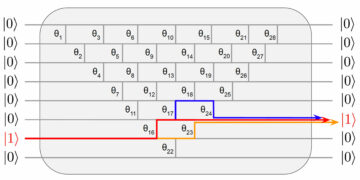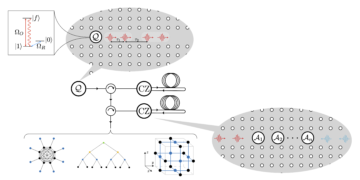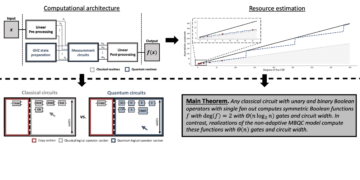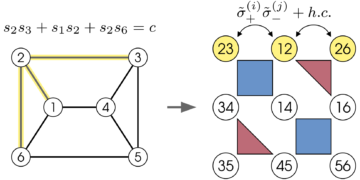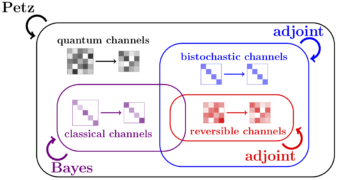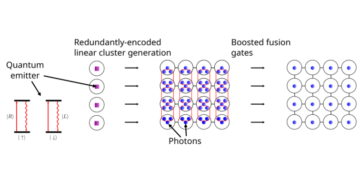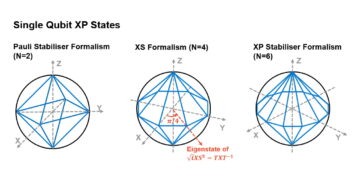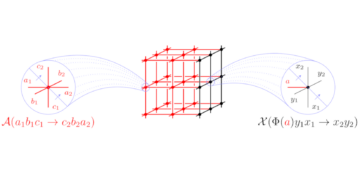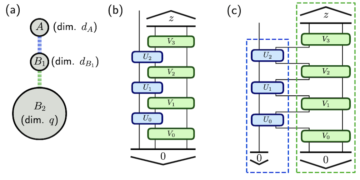1QSTAR, INO-CNR and LENS, Largo Enrico Fermi 2, 50125 Firenze, Italy.
2LNE-SYRTE, Observatoire de Paris, Université PSL, CNRS, Sorbonne Université 61 avenue de l’Observatoire, 75014 Paris, France
Find this paper interesting or want to discuss? Scite or leave a comment on SciRate.
Abstract
Thanks to common-mode noise rejection, differential configurations are crucial for realistic applications of phase and frequency estimation with atom interferometers. Currently, differential protocols with uncorrelated particles and mode-separable settings reach a sensitivity bounded by the standard quantum limit (SQL). Here we show that differential interferometry can be understood as a distributed multiparameter estimation problem and can benefit from both mode and particle entanglement. Our protocol uses a single spin-squeezed state that is mode-swapped among common interferometric modes. The mode swapping is optimized to estimate the differential phase shift with sub-SQL sensitivity. Numerical calculations are supported by analytical approximations that guide the optimization of the protocol. The scheme is also tested with simulation of noise in atomic clocks and interferometers.
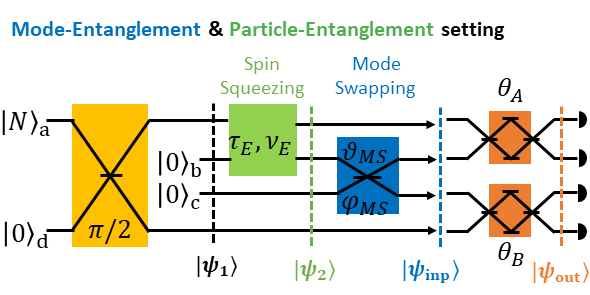
Popular summary
Currently, differential protocols with uncorrelated particles and mode-separable settings reach a sensitivity bounded by the standard quantum limit (SQL).
Here we show that differential interferometry can be understood as a distributed multiparameter estimation problem and can benefit from both mode and particle entanglement.
Our protocol uses a single spin-squeezed state that is mode-swapped among common interferometric modes.
The mode swapping is optimized to estimate the differential phase shift with sub-SQL sensitivity.
► BibTeX data
► References
[1] P. R. Berman, Atom Interferometry. Academic Press, San Diego, 1997. DOI: https://doi.org/10.1016/B978-0-12-092460-8.X5000-0.
https://doi.org/10.1016/B978-0-12-092460-8.X5000-0
[2] A. D. Cronin, J. Schmiedmayer and D. E. Pritchard, Optics and interferometry with atoms and molecules, Reviews of Modern Physics, 81, 1051 (2009). DOI: https://doi.org/10.1103/RevModPhys.81.1051.
https://doi.org/10.1103/RevModPhys.81.1051
[3] G. M. Tino and M. A. Kasevich, Atom Interferometry: Proceedings of the International School of Physics “Enrico Fermi”, Course 188 Societá Italiana di Fisica, Bologna, 2014. ISBN print: 978-1-61499-447-3.
[4] M. S. Safronova, D. Budker, D. DeMille, D. F. J. Kimball, A. Derevianko and C. W. Clark, Search for new physics with atoms and molecules, Rev. Mod. Phys. 90, 025008 (2018). DOI: https://doi.org/10.1103/RevModPhys.90.025008.
https://doi.org/10.1103/RevModPhys.90.025008
[5] K. Bongs, M. Holynski, J. Vovrosh, P. Bouyer, G. Condon, E. Rasel, C. Schubert, W. P. Schleich, and A. Roura, Taking atom interferometric quantum sensors from the laboratory to real-world applications, Nature Reviews Physics 1, 731 (2019). DOI: https://doi.org/10.1038/s42254-019-0117-4.
https://doi.org/10.1038/s42254-019-0117-4
[6] R. Geiger, A. Landragin, S. Merlet, and F. Pereira Dos Santos, High-accuracy inertial measurements with cold-atom sensors, AVS Quantum Sci. 2, 024702 (2020). DOI: https://doi.org/10.1116/5.0009093.
https://doi.org/10.1116/5.0009093
[7] N. Poli, C.W. Oates, P. Gill and G.M. Tino, Optical atomic clocks, La Rivista del Nuovo Cimento, 36, 555 (2013). DOI: https://doi.org/10.1393/ncr/i2013-10095-x.
https://doi.org/10.1393/ncr/i2013-10095-x
[8] A. D. Ludlow, M. M. Boyd, J. Ye, E. Peik and P. O. Schmidt, Optical atomic clocks, Rev. Mod. Phys. 87, 637 (2015). DOI: https://doi.org/10.1103/RevModPhys.87.637.
https://doi.org/10.1103/RevModPhys.87.637
[9] G. T. Foster, J. B. Fixler, J. M. McGuirk and M. A. Kasevich, Method of phase extraction between coupled atom interferometers using ellipse-specific fitting, Opt. Lett. 27, 951 (2002). DOI: https://doi.org/10.1364/OL.27.000951.
https://doi.org/10.1364/OL.27.000951
[10] K. Eckert, P. Hyllus, D. Bruß, U. V. Poulsen, M. Lewenstein, C. Jentsch, T. Müller, E. M. Rasel and W. Ertmer, Differential atom interferometry beyond the standard quantum limit, Phys. Rev. A 73, 013814 (2006). DOI: https://doi.org/10.1103/PhysRevA.73.013814.
https://doi.org/10.1103/PhysRevA.73.013814
[11] J. K. Stockton, X. Wu and M. A. Kasevich, Bayesian estimation of differential interferometer phase, Phys. Rev. A 76, 033613 (2007). DOI: https://doi.org/10.1103/PhysRevA.76.033613.
https://doi.org/10.1103/PhysRevA.76.033613
[12] G. Varoquaux, R. A. Nyman, R. Geiger, P. Cheinet, A. Landragin and P. Bouyer, How to estimate the differential acceleration in a two-species atom interferometer to test the equivalence principle, New J. of Phys. 11, 113010 (2009). DOI: https://doi.org/10.1088/1367-2630/11/11/113010.
https://doi.org/10.1088/1367-2630/11/11/113010
[13] F. Pereira Dos Santos, Differential phase extraction in an atom gradiometer, Phys. Rev. A 91, 063615 (2015). DOI: https://doi.org/10.1103/PhysRevA.91.063615.
https://doi.org/10.1103/PhysRevA.91.063615
[14] M. Landini, M. Fattori, L. Pezzè and A Smerzi, Phase-noise protection in quantum-enhanced differential interferometry, New. J. Phys. 16, 113074 (2014). DOI: https://doi.org/10.1088/1367-2630/16/11/113074.
https://doi.org/10.1088/1367-2630/16/11/113074
[15] F. Sorrentino, Q. Bodart, L. Cacciapuoti, Y.-H. Lien, M. Prevedelli, G. Rosi, L. Salvi and G. M. Tino, Sensitivity limits of a Raman atom interferometer as a gravity gradiometer, Phys. Rev. A 89, 023607 (2014). DOI: https://doi.org/10.1103/PhysRevA.89.023607.
https://doi.org/10.1103/PhysRevA.89.023607
[16] A. Trimeche, B. Battelier, D. Becker, A. Bertoldi, P. Bouyer, C. Braxmaier, E. Charron, R. Corgier, M. Cornelius, K. Douch, N. Gaaloul, S. Herrmann, J. Müller, E. Rasel, C. Schubert, H. Wu and F. Pereira dos Santos, Concept study and preliminary design of a cold atom interferometer for space gravity gradiometry, Class. Quantum Grav. 36, 215004 (2019). DOI: https://doi.org/10.1088/1361-6382/ab4548.
https://doi.org/10.1088/1361-6382/ab4548
[17] J. M. McGuirk, G. T. Foster, J. B. Fixler, M. J. Snadden and M. A. Kasevich, Sensitive absolute-gravity gradiometry using atom interferometry, Phys. Rev. A 65, 033608 (2002). DOI: https://doi.org/10.1103/PhysRevA.65.033608.
https://doi.org/10.1103/PhysRevA.65.033608
[18] I. Perrin, Y. Bidel, N. Zahzam, C. Blanchard, A. Bresson and M. Cadoret, Proof-of-principle demonstration of vertical-gravity-gradient measurement using a single-proof-mass double-loop atom interferometer, Phys. Rev. A 99, 013601 (2019). DOI: https://doi.org/10.1103/PhysRevA.99.013601.
https://doi.org/10.1103/PhysRevA.99.013601
[19] R. Caldani, K. X. Weng, S. Merlet and F. Pereira Dos Santos, Simultaneous accurate determination of both gravity and its vertical gradient, Phys. Rev. A 99, 033601 (2019). DOI: https://doi.org/10.1103/PhysRevA.99.033601.
https://doi.org/10.1103/PhysRevA.99.033601
[20] G. Rosi, L. Cacciapuoti, F. Sorrentino, M. Menchetti, M. Prevedelli and G. M. Tino, Measurement of the Gravity-Field Curvature by Atom Interferometry, Phys. Rev. Lett. 114, 013001 (2015). DOI: https://doi.org/10.1103/PhysRevLett.114.013001.
https://doi.org/10.1103/PhysRevLett.114.013001
[21] D. Philipp, E. Hackmann, C. Lämmerzahl and J. Müller Relativistic geoid: Gravity potential and relativistic effects Phys. Rev. D 101, 064032 (2020). DOI: https://doi.org/10.1103/PhysRevD.101.064032.
https://doi.org/10.1103/PhysRevD.101.064032
[22] G. Rosi, F. Sorrentino, L. Cacciapuoti, M. Prevedelli and G. M. Tino, Precision measurement of the Newtonian gravitational constant using cold atoms, Nature 510, 518–521 (2014). DOI: https://doi.org/10.1038/nature13433.
https://doi.org/10.1038/nature13433
[23] D. Schlippert, J. Hartwig, H. Albers, L.L. Richardson, C. Schubert, A. Roura, W.P. Schleich, W. Ertmer and E.M. Rasel, Quantum Test of the Universality of Free Fall, Phys. Rev. Lett. 112, 203002 (2014). DOI: https://doi.org/10.1103/PhysRevLett.112.203002.
https://doi.org/10.1103/PhysRevLett.112.203002
[24] B. Barrett, L. Antoni-Micollier, L. Chichet, B. Battelier, T. Lévèque, A. Landragin and P. Bouyer, Dual matter-wave inertial sensors in weightlessness, Nature Communications 7, 13786 (2016). DOI: https://doi.org/10.1038/ncomms13786.
https://doi.org/10.1038/ncomms13786
[25] G. Rosi, G. D’Amico, L. Cacciapuoti, F. Sorrentino, M. Prevedelli, M. Zych, Č. Brukner and G.M. Tino, Quantum test of the equivalence principle for atoms in coherent superposition of internal energy states, Nature Communications 8, 15529 (2017). DOI: https://doi.org/10.1038/ncomms15529.
https://doi.org/10.1038/ncomms15529
[26] P. Asenbaum, C. Overstreet, M. Kim, J. Curti and M.A. Kasevich, Atom-Interferometric Test of the Equivalence Principle at the 10-12 Level, Phys. Rev. Lett. 125, 191101 (2020). DOI: https://doi.org/10.1103/PhysRevLett.125.191101.
https://doi.org/10.1103/PhysRevLett.125.191101
[27] B. Barrett, G. Condon, L. Chichet, L. Antoni-Micollier, R. Arguel, M. Rabault, C. Pelluet, V. Jarlaud, A. Landragin, P. Bouyer and B. Battelier, Testing the universality of free fall using correlated 39K–87Rb atom interferometers, AVS Quantum Sci. 4, 014401 (2022). DOI: https://doi.org/10.1116/5.0076502.
https://doi.org/10.1116/5.0076502
[28] G.M. Tino and F. Vetrano, Is it possible to detect gravitational waves with atom interferometers? Class. Quantum Grav. 24, 2167 (2007). DOI: https://doi.org/10.1088/0264-9381/24/9/001.
https://doi.org/10.1088/0264-9381/24/9/001
[29] S. Dimopoulos, P. W. Graham, J. M. Hogan, M. A. Kasevich and S. Rajendran, Atomic gravitational wave interferometric sensor, Phys. Rev. D 78, 122002 (2008). DOI: https://doi.org/10.1103/PhysRevD.78.122002.
https://doi.org/10.1103/PhysRevD.78.122002
[30] P. W. Graham, J. M. Hogan, M. A. Kasevich and S. Rajendran, New Method for Gravitational Wave Detection with Atomic Sensors, Phys. Rev. Lett. 110, 171102 (2013). DOI: https://doi.org/10.1103/PhysRevLett.110.171102.
https://doi.org/10.1103/PhysRevLett.110.171102
[31] B. Canuel et al., ELGAR—a European Laboratory for Gravitation and Atom-interferometric Research, Class. Quantum Grav. 37, 225017 (2020). DOI: https://doi.org/10.1088/1361-6382/aba80e.
https://doi.org/10.1088/1361-6382/aba80e
[32] C. W. Chou, D. B. Hume, M. J. Thorpe, D. J. Wineland and T. Rosenband, Quantum Coherence between Two Atoms beyond $Q=10^{15}$, Phys. Rev. Lett. 106, 160801 (2011). DOI: https://doi.org/10.1103/PhysRevLett.106.160801.
https://doi.org/10.1103/PhysRevLett.106.160801
[33] E. R. Clements, M.E. Kim, K. Cui, A. M. Hankin, S. M. Brewer, J. Valencia, J.-S. Chen, C.-W. Chou, D. R. Leibrandt and D. B. Hume, Lifetime-Limited Interrogation of Two Independent ${}^{27}$Al$^+$ Clocks Using Correlation Spectroscopy, Phys. Rev. Lett. 125, 243602 (2020). DOI: https://doi.org/10.1103/PhysRevLett.125.243602.
https://doi.org/10.1103/PhysRevLett.125.243602
[34] C. W. Chou, D. B. Hume, T. Rosenband and D. J. Wineland, Optical Clocks and Relativity, Science 329, 1630 (2010). DOI: https://doi.org/10.1126/science.1192720.
https://doi.org/10.1126/science.1192720
[35] T. Bothwell, C. J. Kennedy, A. Aeppli, D. Kedar, J. M. Robinson, E. Oelker, A. Staron and J. Ye, Resolving the gravitational redshift across a millimetre-scale atomic sample, Nature 602, 420 (2022). DOI: https://doi.org/10.1038/s41586-021-04349-7.
https://doi.org/10.1038/s41586-021-04349-7
[36] X. Zheng, J. Dolde, V. Lochab, B. N. Merriman, H. Li and S. Kolkowitz, Differential clock comparisons with a multiplexed optical lattice clock, Nature 602, 425 (2022). DOI: https://doi.org/10.1038/s41586-021-04344-y.
https://doi.org/10.1038/s41586-021-04344-y
[37] M. Gessner, L. Pezzè and A. Smerzi, Sensitivity bounds for multiparameter quantum metrology Phys. Rev. Lett. 121, 130503 (2018). DOI: https://doi.org/10.1103/PhysRevLett.121.130503.
https://doi.org/10.1103/PhysRevLett.121.130503
[38] L.-Z. Liu, et al. Distributed quantum phase estimation with entangled photons, Nat. Phot. 15, 137–142 (2021). DOI: https://doi.org/10.1038/s41566-020-00718-2.
https://doi.org/10.1038/s41566-020-00718-2
[39] A. Gauguet, B. Canuel, T. Lévèque, W. Chaibi and A. Landragin, Characterization and limits of a cold-atom Sagnac interferometer, Phys. Rev. A 80, 063604 (2009). DOI: https://doi.org/10.1103/PhysRevA.80.063604.
https://doi.org/10.1103/PhysRevA.80.063604
[40] C. Janvier, V. Ménoret, B. Desruelle, S. Merlet, A. Landragin and F. Pereira dos Santos, Compact differential gravimeter at the quantum projection-noise limit, Phys. Rev. A 105, 022801 (2022). DOI: https://doi.org/10.1103/PhysRevA.105.022801.
https://doi.org/10.1103/PhysRevA.105.022801
[41] This bound is obtained considering the relation $Delta^2 (theta_A – theta_B) = Delta^2 theta_A + Delta^2 theta_B$, valid for independent interferometers, and taking coherent spin states of $N_A$ and $N_B$ particles, respectively, such that $Delta^2 theta_{A,B}=1/N_{A,B}$, independently from the value of $theta_{A,B}$. Finally, the optimal separable configuration is obtained for $N_A=N_B=N/2$, giving $Delta^2 (theta_A – theta_B)_{rm SQL}=4/N$.
[42] L. Pezzè, A. Smerzi, M. K. Oberthaler, R. Schmied and P. Treutlein, Quantum metrology with nonclassical states of atomic ensembles, Rev. Mod. Phys. 90, 035005 (2018). DOI: https://doi.org/10.1103/RevModPhys.90.035005.
https://doi.org/10.1103/RevModPhys.90.035005
[43] S.S. Szigeti, O. Hosten and S.A. Haine, Improving cold-atom sensors with quantum entanglement: Prospects and challenges, Appl. Phys. Lett. 118, 140501 (2021). DOI: https://doi.org/10.1063/5.0050235.
https://doi.org/10.1063/5.0050235
[44] S. S. Szigeti, S. P. Nolan, J. D. Close and S. A. Haine, High-Precision Quantum-Enhanced Gravimetry with a Bose-Einstein Condensate, Phys. Rev. Lett. 125, 100402 (2020). DOI: https://doi.org/10.1103/PhysRevLett.125.100402.
https://doi.org/10.1103/PhysRevLett.125.100402
[45] R. Corgier, L. Pezzè and A. Smerzi, Nonlinear Bragg interferometer with a trapped Bose-Einstein condensate, Phys. Rev. A, 103, L061301 (2021). DOI: https://doi.org/10.1103/PhysRevA.103.L061301.
https://doi.org/10.1103/PhysRevA.103.L061301
[46] R. Corgier, N. Gaaloul, A. Smerzi and L. Pezzè, Delta-kick Squeezing, Phys. Rev. Lett. 127, 183401 (2021). DOI: https://doi.org/10.1103/PhysRevLett.127.183401.
https://doi.org/10.1103/PhysRevLett.127.183401
[47] L. Salvi, N. Poli, V. Vuletićand G. M. Tino, Squeezing on momentum states for atom interferometry, Phys. Rev. Lett. 120, 033601 (2018). DOI: https://doi.org/10.1103/PhysRevLett.120.033601.
https://doi.org/10.1103/PhysRevLett.120.033601
[48] G. P. Greve, C. Luo, B. Wu and J. K. Thompson, Entanglement-Enhanced Matter-Wave Interferometry in a High-Finesse Cavity, Nature 610, 472 (2022). DOI: https://doi.org/10.1038/s41586-022-05197-9.
https://doi.org/10.1038/s41586-022-05197-9
[49] F. Anders, A. Idel, P. Feldmann, D. Bondarenko, S. Loriani, K. Lange, J. Peise, M. Gersemann, B. Meyer-Hoppe, S. Abend, N. Gaaloul, C. Schubert, D. Schlippert, L. Santos, E. Rasel and C. Klempt, Momentum entanglement for atom interferometry, Phys. Rev. Lett. 127, 140402 (2021). DOI: https://doi.org/10.1103/PhysRevLett.127.140402.
https://doi.org/10.1103/PhysRevLett.127.140402
[50] M. Huang et al., Self-amplifying spin measurement in a long-lived spin-squeezed state, arXiv: 2007.01964 (2020). DOI: https://doi.org/10.48550/arXiv.2007.01964.
https://doi.org/10.48550/arXiv.2007.01964
[51] A. Louchet-Chauvet, J. Appel, J. J. Renema, D. Oblak, N Kjaergaard and E. S. Polzik, Entanglement-assisted atomic clock beyond the projection noise limit, New J. of Phys. 12 065032 (2010). https://doi.org/10.1088/1367-2630/12/6/065032.
https://doi.org/10.1088/1367-2630/12/6/065032
[52] E. Pedrozo-Peñafiel, S. Colombo, C. Shu, A.F. Adiyatullin, Z. Li, E. Mendez, B. Braverman, A. Kawasaki, D. Akamatsu, Y. Xiao and V. Vuletić, Entanglement on an optical atomic-clock transition, Nature 588, 414-418 (2020). DOI: https://doi.org/10.1038/s41586-020-3006-1.
https://doi.org/10.1038/s41586-020-3006-1
[53] I. Kruse, K. Lange, J. Peise, B. Lücke, L. Pezzè, J. Arlt, W. Ertmer, C. Lisdat, L. Santos, A. Smerzi and C. Klempt, Improvement of an Atomic Clock using Squeezed Vacuum, Phys. Rev. Lett. 117, 143004 (2016). DOI: https://doi.org/10.1103/PhysRevLett.117.143004.
https://doi.org/10.1103/PhysRevLett.117.143004
[54] B. K. Malia, J. Martínez-Rincón, Y. Wu, O. Hosten and Mark A. Kasevich, Free Space Ramsey Spectroscopy in Rubidium with Noise below the Quantum Projection Limit, Phys. Rev. Lett. 125, 043202 (2020). DOI: https://doi.org/10.1103/PhysRevLett.125.043202.
https://doi.org/10.1103/PhysRevLett.125.043202
[55] M. Kitagawa and M. Ueda, Squeezed spin states, Phys. Rev. A 47, 5138 (1993). DOI: https://doi.org/10.1103/PhysRevA.47.5138.
https://doi.org/10.1103/PhysRevA.47.5138
[56] M. Malitesta, A. Smerzi and L. Pezzè, Distributed Quantum Sensing with Squeezed-Vacuum Light in a Configurable Network of Mach-Zehnder Interferometers, arXiv: 2109.09178 (2021). DOI: https://doi.org/10.48550/arXiv.2109.09178.
https://doi.org/10.48550/arXiv.2109.09178
[57] O. Hosten, N. J. Engelsen, R. Krishnakumar and M. Kasevich Measurement noise 100 times lower than the quantum-projection limit using entangled atoms, Nature 529, 505–508 (2016). DOI: https://doi.org/10.1038/nature16176.
https://doi.org/10.1038/nature16176
[58] K. C. Cox, G. P. Greve, J. M. Weiner, and J. K. Thompson, Deterministic squeezed states with collective measurements and feedback, Phys. Rev. Lett. 116, 093602 (2016). DOI: https://doi.org/10.1103/PhysRevLett.116.093602.
https://doi.org/10.1103/PhysRevLett.116.093602
[59] I.D. Leroux, M. H. Schleier-Smith, and V. Vuletić, 2010a, Implementation of cavity squeezing of a collective atomic spin, Phys. Rev. Lett. 104, 073602 (2010). Doi: https://doi.org/10.1103/PhysRevLett.104.073602.
https://doi.org/10.1103/PhysRevLett.104.073602
[60] M. Gessner, A. Smerzi and L. Pezzè, Multiparameter squeezing for optimal quantum enhancements in sensor networks, Nat. Comm. 11, 3817 (2020). DOI: https://doi.org/10.1038/s41467-020-17471-3.
https://doi.org/10.1038/s41467-020-17471-3
[61] S. M. Barnett and P. M. Radmore, Methods of Theoretical Quantum Optics, Claredon Press, Oxford, 1997. ISBN: 9780198563617.
[62] G. Sorelli, M. Gessner, A. Smerzi and L. Pezzè, Fast and optimal generation of entanglement in bosonic Josephson junctions, Phys. Rev. A 99, 022329 (2019). DOI: https://doi.org/10.1103/PhysRevA.99.022329.
https://doi.org/10.1103/PhysRevA.99.022329
[63] The following relations hold between the coefficients $theta_{rm MS}$, $varphi_{rm MS}$ of Eq. (3) and $|u_{bb}|$, $|u_{cb}|$, $delta_{cb}$ in Eq. (9): $|u_{bb}|=cos{theta_{rm MS}}$, $|u_{cb}|=sin{theta_{rm MS}}$, $delta_{cb}=varphi_{rm MS}-pi/2$.
[64] We take a entangled state of $N_A$ particles and an coherent spin state of $N_B = N- N_A$ particles in the interferometers $A$ and $B$, respectively. For the mode-separable case we have $Delta^2 (theta_A – theta_B) = Delta^2 theta_A + Delta^2 theta_B$. Let’s suppose that $Delta^2 theta_A ll Delta^2 theta_B=1/N_B$. The optimization of $Delta^2 (theta_A – theta_B)$ with respect to $N_A$, gives $Delta^2 (theta_A – theta_B) sim 1/N$. Instead, if two interferometers have the same number of particles, $N_A = N_B = N/2$, we obtain $Delta^2 (theta_A – theta_B) sim 2/N$.
[65] M. Schulte, C. Lisdat, P. O. Schmidt, U. Sterr and K. Hammerer, Prospects and challenges for squeezing-enhanced optical atomic clocks, Nature Communication 11, 5955 (2020). DOI: https://doi.org/10.1038/s41467-020-19403-7.
https://doi.org/10.1038/s41467-020-19403-7
[66] J. Peise, I. Kruse, K. Lange, B. Lücke, L. Pezzè, J. Arlt, W. Ertmer, K. Hammerer, L. Santos, A. Smerzi and C. Klempt, Satisfying the Einstein-Podolsky-Rosen criterion with massive particles, Nature Communication 6, 8984 (2015). DOI: https://doi.org/10.1038/ncomms9984.
https://doi.org/10.1038/ncomms9984
[67] C. Gross, H. Strobel, E. Nicklas, T. Zibold, N. Bar-Gill, G. Kurizki and M. K. Oberthaler, Atomic homodyne detection of continuous-variable entangled twin-atom states, Nature 480, 219 (2011). DOI: https://doi.org/10.1038/nature10654.
https://doi.org/10.1038/nature10654
[68] C. D. Hamley, C. S. Gerving, T. M. Hoang, E. M. Bookjans, and M. S. Chapman, Spin-nematic squeezed vacuum in a quantum gas, Nat. Phys. 8, 305 (2012). DOI: https://doi.org/10.1038/nphys2245.
https://doi.org/10.1038/nphys2245
[69] M. D. Reid, Demonstration of the Einstein-Podolsky-Rosen paradox using nondegenerate parametric amplification, Phys. Rev. A 40, 913 (1989). DOI: https://doi.org/10.1103/PhysRevA.40.913.
https://doi.org/10.1103/PhysRevA.40.913
[70] Z. Y. Ou, S. F. Pereira, H. J. Kimble, and K. C. Peng, Realization of the Einstein-Podolsky-Rosen paradox for continuous variables, Phys. Rev. Lett. 68, 3663–3666 (1992). DOI: https://doi.org/10.1103/PhysRevLett.68.3663.
https://doi.org/10.1103/PhysRevLett.68.3663
[71] M. D. Reid, P.D. Drummond, W.P. Bowen, E.G. Cavalcanti, P. K. Lam, H. A. Bachor, U. L. Andersen and G. Leuchs, Colloquium: The Einstein-Podolsky-Rosen paradox: From con- cepts to applications, Rev. Mod. Phys. 81, 1727 (2009). DOI: https://doi.org/10.1103/RevModPhys.81.1727.
https://doi.org/10.1103/RevModPhys.81.1727
[72] Y. Ma, H. Miao, B. Heyun Pang, M. Evans, C. Zhao, J. Harms, R. Schnabel and Y. Chen, Proposal for gravitational-wave detection beyond the standard quantum limit through EPR entanglement, Nature Physics 13, 776 (2017). DOI: https://doi.org/10.1038/nphys4118.
https://doi.org/10.1038/nphys4118
[73] J. Südbeck, S. Steinlechner, M. Korobko and R. Schnabel, Demonstration of interferometer enhancement through Einstein–Podolsky–Rosen entanglement, Nature Photonics 14, 240 (2020). DOI: https://doi.org/10.1038/s41566-019-0583-3.
https://doi.org/10.1038/s41566-019-0583-3
[74] L. Pezzè and A. Smerzi, Heisenberg-limited noisy atomic clock using a hybrid coherent and squeezed state protocol, Phys. Rev. Lett. 125, 210503 (2020). DOI: https://doi.org/10.1103/PhysRevLett.125.210503.
https://doi.org/10.1103/PhysRevLett.125.210503
[75] L. Pezzè and A. Smerzi, Quantum Phase Estimation Algorithm with Gaussian Spin States, PRX Quantum 2, 040301 (2021). DOI: https://doi.org/10.1103/PRXQuantum.2.040301.
https://doi.org/10.1103/PRXQuantum.2.040301
[76] R. Kaubruegger, D. V. Vasilyev, M. Schulte, K. Hammerer and P. Zoller, Quantum Variational Optimization of Ramsey Interferometry and Atomic Clocks, Phys. Rev. X 11, 041045 (2021). DOI: https://doi.org/10.1103/PhysRevX.11.041045.
https://doi.org/10.1103/PhysRevX.11.041045
[77] C. D. Marciniak, T. Feldker, I. Pogorelov, R. Kaubruegger, D. V. Vasilyev, R. van Bijnen, P. Schindler, P. Zoller, R. Blatt and T. Monz, Optimal metrology with programmable quantum sensors, Nature 603, 604 (2022). DOI: https://doi.org/10.1038/s41586-022-04435-4.
https://doi.org/10.1038/s41586-022-04435-4
[78] J. Borregaard and A. S. Sørensen, Near-Heisenberg-Limited Atomic Clocks in the Presence of Decoherence, Phys. Rev. Lett. 111, 090801 (2013). DOI: https://doi.org/10.1103/PhysRevLett.111.090801.
https://doi.org/10.1103/PhysRevLett.111.090801
[79] R. Kohlhaas, A. Bertoldi, E. Cantin, A. Aspect, A. Landragin and P. Bouyer, Phase Locking a Clock Oscillator to a Coherent Atomic Ensemble, Phys. Rev. X 5, 021011 (2015). DOI: https://doi.org/10.1103/PhysRevX.5.021011.
https://doi.org/10.1103/PhysRevX.5.021011
[80] W. Bowden, A. Vianello, I. R. Hill, M. Schioppo and R. Hobson. Improving the Q Factor of an Optical Atomic Clock Using Quantum Nondemolition Measurement, Phys. Rev. X 10, 041052 (2020). DOI: https://doi.org/10.1103/PhysRevX.10.041052.
https://doi.org/10.1103/PhysRevX.10.041052
[81] C. Janvier, V. Ménoret, B. Desruelle, S. Merlet, A. Landragin, and F. Pereira dos Santos, Compact differential gravimeter at the quantum projection-noise limit, Phys. Rev. A 105, 022801 (2022). DOI: https://doi.org/10.1103/PhysRevA.105.022801.
https://doi.org/10.1103/PhysRevA.105.022801
[82] N. Gaaloul, M. Meister, R. Corgier, A. Pichery, P. Boegel, W. Herr, H. Ahlers, E. Charron, J. R. Williams, R. J. Thompson, W. P. Schleich, E. M. Rasel and N. P. Bigelow, A space-based quantum gas laboratory at picokelvin energy scales, Nature Communication 13, 7889 (2022). DOI: https://doi.org/10.1038/s41467-022-35274-6.
https://doi.org/10.1038/s41467-022-35274-6
[83] T. J. Proctor, P. A. Knott and J. A. Dunningham, Multiparameter Estimation in Networked Quantum Sensors, Phys. Rev. Lett. 120, 080501 (2018). DOI: https://doi.org/10.1103/PhysRevLett.120.080501.
https://doi.org/10.1103/PhysRevLett.120.080501
[84] W. Ge, K. Jacobs, Z. Eldredge, A. V. Gorshkov and M. Foss- Feig, Distributed Quantum Metrology with Linear Networks and Separable Inputs, Phys. Rev. Lett. 121, 043604 (2018). DOI: https://doi.org/10.1103/PhysRevLett.121.043604.
https://doi.org/10.1103/PhysRevLett.121.043604
[85] X. Guo, C. R. Breum, J. Borregaard, S. Izumi, M. V. Larsen, T. Gehring, M. Christandl, J. S. Neergaard-Nielsen and U. L. Andersen Distributed quantum sensing in a continuous-variable entangled network, Nat. Phys. 16, 281 (2020). DOI: https://doi.org/10.1038/s41567-019-0743-x.
https://doi.org/10.1038/s41567-019-0743-x
[86] Y. Xia, W. Li, W. Clark, D. Hart, Q. Zhuang, and Z. Zhang, Demonstration of a reconfigurable entangled radio-frequency photonic sensor network, Phys. Rev. Lett. 124, 150502 (2020). DOI: https://doi.org/10.1103/PhysRevLett.124.150502.
https://doi.org/10.1103/PhysRevLett.124.150502
[87] B. K. Malia, Y. Wu, J. Martinez-Rincon, and M. A. Kasevich, Distributed quantum sensing with a mode-entangled network of spin-squeezed atomic states, Nature 612, 661 (2022). DOI: https://doi.org/10.1038/s41586-022-05363-z.
https://doi.org/10.1038/s41586-022-05363-z
Cited by
[1] Holger Ahlers, Leonardo Badurina, Angelo Bassi, Baptiste Battelier, Quentin Beaufils, Kai Bongs, Philippe Bouyer, Claus Braxmaier, Oliver Buchmueller, Matteo Carlesso, Eric Charron, Maria Luisa Chiofalo, Robin Corgier, Sandro Donadi, Fabien Droz, Robert Ecoffet, John Ellis, Frédéric Estève, Naceur Gaaloul, Domenico Gerardi, Enno Giese, Jens Grosse, Aurélien Hees, Thomas Hensel, Waldemar Herr, Philippe Jetzer, Gina Kleinsteinberg, Carsten Klempt, Steve Lecomte, Louise Lopes, Sina Loriani, Gilles Métris, Thierry Martin, Victor Martín, Gabriel Müller, Miquel Nofrarias, Franck Pereira Dos Santos, Ernst M. Rasel, Alain Robert, Noah Saks, Mike Salter, Dennis Schlippert, Christian Schubert, Thilo Schuldt, Carlos F. Sopuerta, Christian Struckmann, Guglielmo M. Tino, Tristan Valenzuela, Wolf von Klitzing, Lisa Wörner, Peter Wolf, Nan Yu, and Martin Zelan, “STE-QUEST: Space Time Explorer and QUantum Equivalence principle Space Test”, arXiv:2211.15412, (2022).
The above citations are from SAO/NASA ADS (last updated successfully 2023-03-31 11:02:47). The list may be incomplete as not all publishers provide suitable and complete citation data.
On Crossref’s cited-by service no data on citing works was found (last attempt 2023-03-31 23:03:04). Could not fetch ADS cited-by data during last attempt 2023-03-31 23:03:04: cURL error 28: Operation timed out after 10001 milliseconds with 0 bytes received
This Paper is published in Quantum under the Creative Commons Attribution 4.0 International (CC BY 4.0) license. Copyright remains with the original copyright holders such as the authors or their institutions.
- SEO Powered Content & PR Distribution. Get Amplified Today.
- Platoblockchain. Web3 Metaverse Intelligence. Knowledge Amplified. Access Here.
- Source: https://quantum-journal.org/papers/q-2023-03-30-965/
- :is
- ][p
- 1
- 10
- 100
- 11
- 110
- 116
- 2011
- 2012
- 2014
- 2016
- 2017
- 2018
- 2019
- 2020
- 2021
- 2022
- 28
- 39
- 420
- 67
- 7
- 70
- 77
- 8
- 84
- 9
- a
- above
- ABSTRACT
- academic
- acceleration
- access
- accurate
- across
- affiliations
- After
- AL
- algorithm
- All
- among
- Amplification
- Analytical
- and
- Andersen
- applications
- ARE
- AS
- aspect
- At
- atom
- author
- authors
- Avenue
- Bayesian
- BE
- below
- benefit
- between
- Beyond
- bound
- Break
- by
- CAN
- case
- challenges
- chen
- class
- Claus
- Clock
- Clocks
- Close
- COHERENT
- Collective
- comm
- comment
- Common
- Commons
- Communication
- Communications
- complete
- concept
- Configuration
- configurations
- considering
- constant
- continuous
- copyright
- Correlation
- could
- coupled
- course
- crucial
- Currently
- data
- Den
- Design
- Detection
- determination
- Diego
- discuss
- distributed
- DOS
- during
- e
- effects
- energy
- error
- estimate
- Ether (ETH)
- European
- explorer
- extraction
- Fall
- FAST
- feedback
- Finally
- fitting
- following
- For
- Foster
- found
- Free
- Frequency
- from
- GAS
- ge
- generation
- Gilles
- gives
- Giving
- gravitational
- Gravitational waves
- gravity
- gross
- guide
- harms
- harvard
- Have
- here
- hold
- holders
- How
- How To
- HTTPS
- Hume
- Hybrid
- i
- implementation
- improvement
- improving
- in
- independent
- independently
- instead
- institutions
- interesting
- internal
- International
- IT
- Italy
- ITS
- JavaScript
- John
- journal
- Kim
- laboratory
- Last
- Leave
- Lens
- Level
- License
- light
- LIMIT
- limits
- List
- Marco
- mark
- Martin
- massive
- max-width
- measurements
- method
- methods
- Metrology
- Mode
- Modern
- modes
- Momentum
- Month
- Nature
- network
- networks
- New
- Noah
- Noise
- number
- obtain
- obtained
- of
- on
- open
- operation
- optical
- optics
- optimal
- optimization
- optimized
- original
- Oxford
- Paper
- Paradox
- paris
- particle
- Peter
- phase
- Philippe
- Photons
- Physics
- plato
- Plato Data Intelligence
- PlatoData
- possible
- potential
- Precision
- presence
- press
- principle
- Problem
- Proceedings
- Projection
- proposal
- prospects
- protection
- protocol
- protocols
- provide
- PSL
- published
- publisher
- publishers
- Quantum
- quantum entanglement
- Quantum optics
- Quantum sensors
- reach
- real world
- realistic
- realization
- references
- relation
- relations
- remains
- research
- resolving
- respect
- Reviews
- ROBERT
- Robin
- s
- same
- San
- San Diego
- scales
- scheme
- School
- SCI
- Science
- Search
- sensitive
- Sensitivity
- sensors
- settings
- shift
- show
- SIM
- simulation
- simultaneous
- single
- Space
- space-based
- Spectroscopy
- Spin
- SQL
- standard
- State
- States
- Steve
- Study
- Successfully
- such
- suitable
- superposition
- Supported
- Take
- taking
- test
- Testing
- that
- The
- their
- theoretical
- thompson
- Through
- time
- Timed
- times
- Title
- to
- transition
- uncorrelated
- under
- understood
- updated
- URL
- Vacuum
- value
- variables
- volume
- von
- W
- Wave
- waves
- with
- Wolf
- works
- wu
- X
- year
- zephyrnet
- Zhao

